Bose QuietComfort 20 Acoustic Noise Cancelling Headphones Review
The new Bose QuietComfort 20 headphones or earbuds are amazing…under most conditions.
Throw the switch and most of the external sounds are immediately hushed.
When riding a motorcycle, however, the system only dampens noise to about the same level as a good pair of disposable ear plugs.
The Bose QuietComfort 20 Acoustic Noise Cancelling Headphones don’t seem to work as well with some types of noise.
These include short-duration loud noises like the rapid-fire “pop pop pop” of a motorcycle exhaust.
Some of the helmet wind noise and even voices aren’t attenuated as much as we’d like also.
The wires at either end of the thin battery are permanently attached.
This design makes it very difficult or impossible to feed the wire through the headphone ports installed on some motorcycle jackets; a male/female mini-jack extender is necessary.
Fitting headphones (as Bose refers to them) or earbuds under a motorcycle helmet is always a problem also and the silicone tips of the Bose QC20 system don’t fit very deeply in the ear canal.
Thus, care must be taken to keep the in-ear headphones in place as the helmet is placed on the head.
For motorcycle use, the noise cancellation feature and the sound quality of the Bose QuietComfort 20 headphones provides a better environment for listening to music while riding than any other earbuds we’ve tried.
But $300 is a lot to spend, no doubt about that.
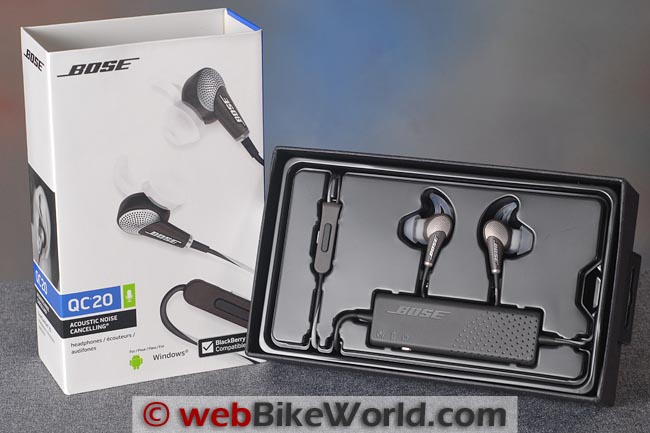
Introduction
The subject of ear plugs, hearing loss and helmet noise has been a continuing thread through webBikeWorld reviews since the beginning of the website nearly 14 years ago.
In fact, there’s an entire page devoted to Motorcycle Helmet Noise that has some background information on this topic.
In several ear plug reviews and motorcycle helmet reviews, the Editor wistfully pined for a company like Bose to partner with a helmet manufacturer to make some type of on-board noise-cancelling device.
That wish has almost become reality with the release of the new Bose QuietComfort 20 Acoustic Noise Cancelling Headphones.
Several other noise cancelling earbud reviews have been published on webBikeWorld over the years, but we haven’t found a set that makes anything more than a barely noticeable difference.
And a few more noise reducing earbud systems were evaluated but never reviewed, simply because they didn’t add anything to the discussion (i.e., they didn’t work).
So as far as we know, you’re not going to get something for nothing.
You’ll either have to spend big bucks if you want to listen to music or hear a cell phone when riding, or buy a pair of cheap, disposable ear plugs and forget the music.
By the way, the Bose QuietComfort 20 Acoustic Noise Cancelling Headphones kit is available as either the QC 20 or the QC 20i.
Here’s the difference: the QC20 kit has two buttons on the mic/phone switch that hangs at the base of the “Y” formed by the headset. It is for an Android, BlackBerry or Windows phone.
The QC 20i version of the kit has four buttons, and it’s for an iPhone or iPod. The extra buttons add volume, music control and voice commands.
So be careful what you order. I’m not sure if one will work with another; I don’t see why not, but we have only Android devices here so I don’t know.
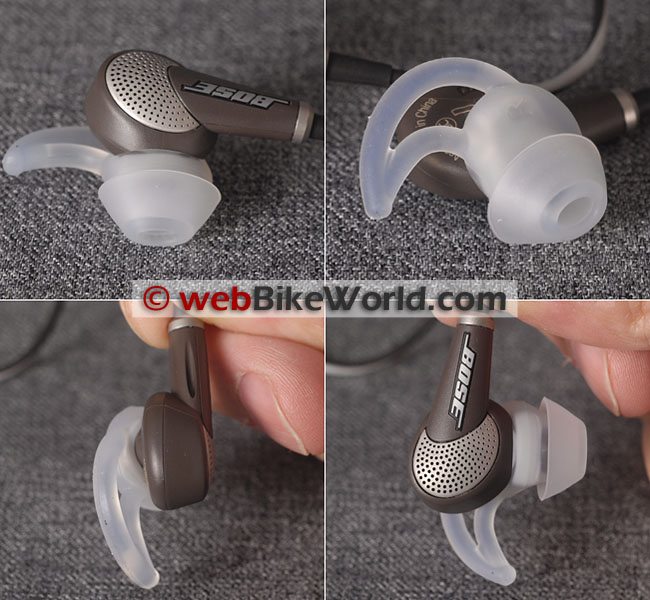
Where to Buy Bose QuietComfort 20
Check Reviews & Prices on AmazonSee More: Motorcycle Accessories, Motorcycle Tire, Motorcycle Helmets
Noise Cancelling…or Noise Reducing?
Let’s take it right to the bottom line: the Bose QuietComfort 20 Acoustic Noise Cancelling Headphones are excellent performers.
But in my book, they do not “cancel” noise, they reduce it — and not all of it is reduced equally.
I’m a bit surprised that Bose calls these “Noise Cancelling” rather than “Noise Reducing” earphones, although I suppose that in the end, it’s a matter of semantics.
The Bose QuietComfort 20 headphones (Bose calls them “headphones” and not “earbuds”) do reduce most of the surrounding noise quite dramatically.
And they do it much, much better by a big margin than any other noise reducing earbud systems we have tried.
We noticed this right away and just about every time I try them in a new sound environment, I’m very impressed.
But in my definition of the word “cancel”, they do not “cancel” noise — or let’s say they don’t cancel all noise.
They do reduce the overall ambient noise levels.
Again, perhaps it is a matter of semantics, but I think the point is important.
You will note this when I get to the part about riding with the Bose QuietComfort 20 system on a motorcycle, where the external sounds are reduced, but not as much as we’d hoped.
Just as a side note, I have never owned a pair of the full-size Bose noise cancelling over-the-ear headphones.
So I am comparing the Bose QuietComfort 20 in-ear headphones to other noise cancelling earbuds we have reviewed on webBikeWorld and also to the Moldex PuraFit 6800 ear plugs that are a favorite around here.
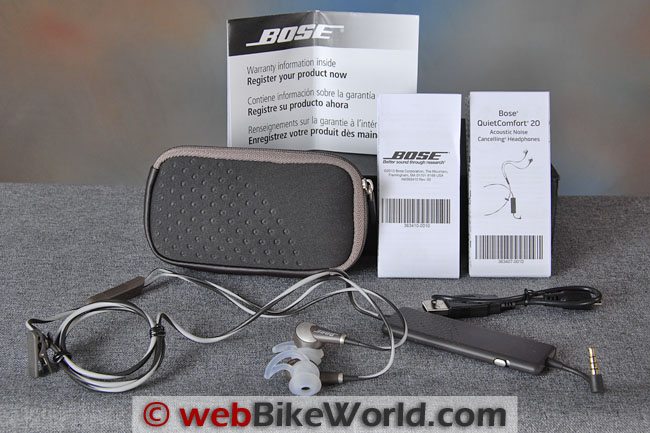
Bose QuietComfort 20 Performance
We just happened to be standing in the Editor’s garage when the UPS driver arrived with the package from Bose. We quickly tore open the small shipping box to take a look.
Just by coincidence, the neighbor happened to be mowing his lawn on a riding garden tractor — a perfect test!
We gave the brief instruction set (printed in 18 different languages!) a quick once-over to get oriented, then I popped the headphones in my ears and flipped the switch to turn them on.
Wow! Pretty amazing. I am certifiably impressed, no two ways about it!
These things work. It’s amazing actually. You throw the switch and the world simply quiets down by about a factor of 10. Literally.
The loud and obnoxious noise from the lawnmower turned into a tiny far-off background thrum that sounded more like someone ruffling paper in the next room.
However — and also by coincidence — a neighborhood kid decided just at that moment to tear up the street on his ATV, which apparently had been modified with an aftermarket exhaust.
The ATV noise was noticeable right away, even with the Bose system switched on.
The ATV exhaust sounded much louder than I expected; it was like the system dampened the noise from the lawnmower but couldn’t cope with the sharp rattle of the exhaust.
This characteristic proved itself a couple of times more during our evaluation.
Apparently, the Bose QuietComfort 20 headphones work much better with some types of noises.
Those would be the continuous droning type sounds.
They work better with those types than they do with fast duration loud sounds, such as a popping muffler or even someone talking nearby.
In fact, I could hear my shoes as I walked on the garage floor, even while other background noises were well muted.
This may be a deliberate design feature by Bose, but there’s nothing I see in their information that indicates this is so.
Turn on the Bose QC20 headphones when watching TV, for example, and the speaker’s voice is reduced.
But it is still louder than I expected, compared to the rest of the background noise, which becomes muted.
Wear the headphones in a restaurant (I tried it) and turn them on and the overall background clatter is greatly reduced. But someone speaking directly to you can be heard.
So my conclusion is that the Bose system apparently can reduce the overall noise levels from something like an exhaust sound or similar.
But not to the same degree that it attenuates the “droning” types of sounds emanating from sources such as a lawnmower, airplane cabin noise, restaurant noise or traffic whooshing by on the freeway.
I’m also surprised that the Bose system doesn’t reduce the voice or talking sounds as much as I had hoped.
I read a magazine review of the Bose QuietComfort 20 headphones and the reviewer was very specific about how any talking in the background turns to a whisper, but I find this to be not the case at all, which leaves me puzzled.
And no, I did not have the Bose “Aware Mode” turned on (more on that in a bit).
I’m assuming that the Bose noise cancelling headphones of both the over-the-ear and in-ear type will be used mostly by airplane passengers. I see Bose headphones quite often on flights.
So I’d also surmise that the system is tuned to eliminate the type of continuous droning noise you hear on a plane, and my experience with the QC20 pretty much backs up this supposition.
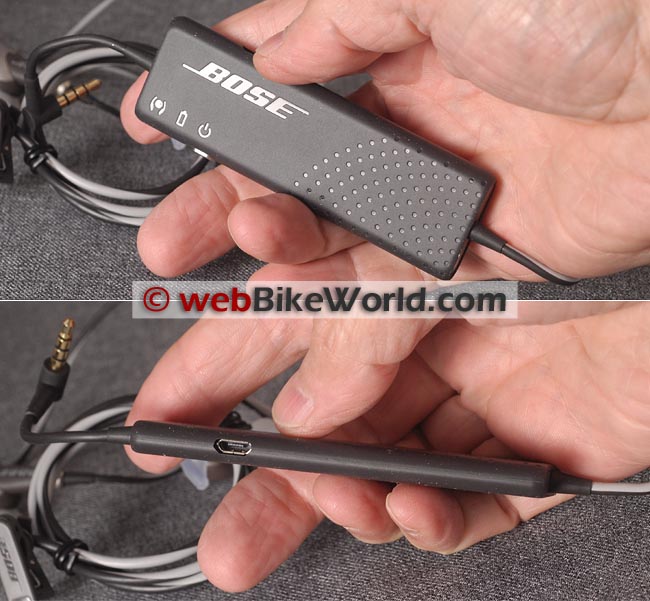
Where to Buy Bose QuietComfort 20
Check Reviews & Prices on AmazonSee More: Motorcycle Accessories, Motorcycle Tire, Motorcycle Helmets
Bose QuietComfort 20 and Motorcycle Exhaust Noise
We fired up the Editor’s Suzuki DR650 (blog) to go for a ride, as the ultimate Bose QuietComfort 20 evaluation.
This DR650 has an aftermarket FMF performance exhaust, which barks pretty loud when the throttle is twisted, although the noise recedes into the background at cruising speeds.
We found that the Bose QuietComfort 20 headphones do reduce the overall sound levels, but not as much as we had hoped.
The sound level when riding and using the Bose system seems about equivalent to a pair of good-quality soft disposable ear plugs.
However, some types of noise are actually slightly louder — or less attenuated — when using the Bose system than with the ear plugs.
For example, the DR650 exhaust sounds are louder with the Bose QuietComfort 20 headphones switched on than they are with the ear plugs.
The Bose system doesn’t perform any better when riding behind a windscreen on a quieter bike than it does on the DR650 either, in my experience.
In fact, for some reason, helmet wind noise seems more noticeable when wearing the Bose QC20 headphones than when wearing the Moldex PuraFit 6800 ear plugs.
The Bose headphones do reduce the overall noise levels to about what you’d get with a good pair of correctly inserted disposable ear plugs.
But they just don’t reduce the noise levels, or certain types of noise, as much as we’d hoped when riding a motorcycle.
This effect may have something to do with the types of sound that the Bose headphones are designed to reduce.
That is, nothing in the Bose literature says anything about wearing them with a motorcycle helmet, so we’re pretty sure this wasn’t considered during the design.
Perhaps they are “tuned” to reduce certain sound frequencies but the noise inside a motorcycle helmet and an exhaust are beyond the scope of intended use.
Another factor may be related to the Bose “StayHear+” silicone earbud/headphone tips that are inserted in the ear.
These do not expand to fill the ear canal like a pair of foam disposable ear plugs, so it’s possible that more sound leaks in around the sides of the Bose headphone tips, which accounts for our findings.
I’ve always had problems fitting this type of earbud in my ears anyway.
The Bose system is better than average in this regard and it does stay inserted, but it still isn’t as deeply fitted into my ear canals than a pair of disposable ear plugs.
Once again, just to be clear about this, the Bose QuietComfort 20 system definitely reduces the overall noise levels when it is worn underneath a motorcycle helmet when riding, but not as much as we had hoped.
The sound reduction seems to be about the same as wearing a pair of good quality, correctly inserted, disposable foam ear plugs.
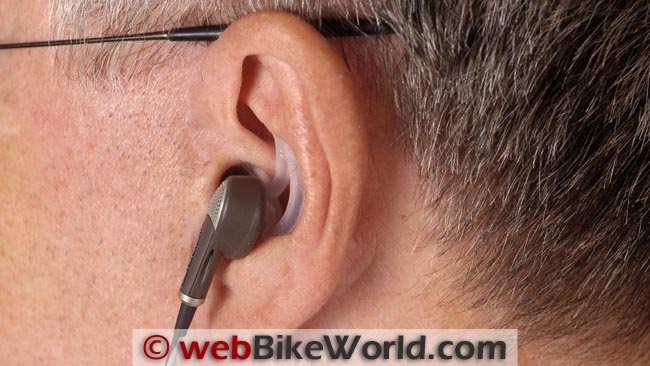
Features and Build Quality
300 bucks is a lot to pay for a pair of earbuds — noise cancelling or not. Bose products have many fans and some detractors and I won’t get into that here.
But the quality of the Bose QuietComfort 20 Acoustic Noise Cancelling Headphones appears to be very good.
The fit and finish and the wiring all seems first rate and the connections or joints between the wires and the headphones and battery seem strong enough to last, with some care.
The only issue I had right away is with the on/off switch, which is located on the side of the battery.
It doesn’t have a solid “click” feel when it’s turned on or off and sometimes it gets caught between on and off if isn’t pushed with a sharp jolt.
The system takes about 1 second to switch on and off, and I don’t know if this is correct or if it’s the switch that isn’t quite engaging fast enough.
I’ll have to be careful to watch it and make sure the switch doesn’t break; it just doesn’t give me a lot of confidence in the way its designed, built or how it functions.
Is the quality commensurate with a $299.95 list price? Hmmm…
These are, after all, simply a pair of speakers you put in your ears. It’s difficult or nigh impossible to know how well they will hold up over the long term. And there is that price…
I’m sure that the fact that these are worth $299.95 will be motivation enough to help me to remember to take care of them.
The Bose QuietComfort 20 kit comes with a nice soft fabric carrying bag and a mini-USB cable for recharging the battery.
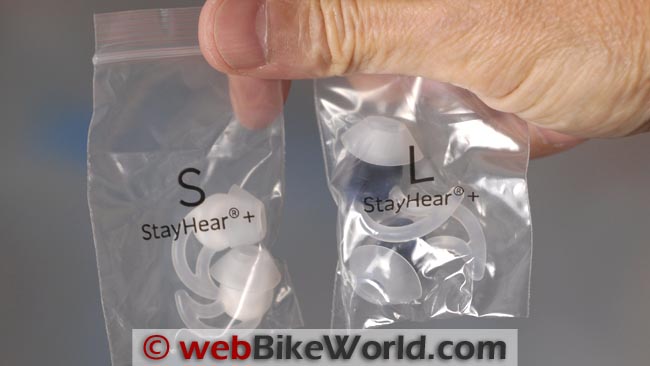
Battery Ups and Downs
The Bose QC20 system battery had a full charged when ours arrived. Bose claims that the battery will recharge in about two hours and should last for about 16 hours of noise cancellation time.
The good news is that the earbuds — excuse me, in-ear headphones — will still play without the battery.
This has not been the case with Bose noise cancelling over-the-ear headphones.
There’s a switch on the side of the 7 mm thin battery (it’s 91 mm long by 28.5 mm wide) to turn the noise cancelling system on or off.
And when it’s turned off, music or the connected device can still be heard, although the sound quality seems different, probably due to the absence of the noise cancelling effect if the switch is turned off.
The bad news is that the wires going into the battery are permanently attached.
This means it’s nigh on impossible to fit the wire through the earbud port now found on many motorcycle jackets, like my Joe Rocket Phoenix (review) and others.
I may buy a mini-jack extension cord; I wish I could find one about 1 meter long but the shortest I’ve seen is this 6 ft. Cables to Go 3.5 mm male/female extension cable version for 3 bucks.
The other problem with the permanently attached wires on the Bose QC20 system is that the mini-jack side of the wire coming out of the battery (i.e., the wire that attaches to the cell phone or music player) is only about 55 mm long.
This means that the battery will remain very close to whatever device you have the QC20 system connected to.
When you carry the cell phone or MP3 player, you have to carry the battery right along with it also.
I think the QC20 really needs to have a detachable wire on the device connection side that’s maybe 40 cm long or so.
Note that you do not need to have the QC20 system attached to a device to get the noise reducing function.
It will reduce noise whether or not it’s connected to an MP3 player or cell phone; simply throw the switch to activate the noise cancelling feature.
For motorcycle riding, if you want to separate the device you’re listening to, like a cell phone or MP3 player, from the battery to locate the player or phone somewhere on the bike to control it, you may need a longer wire.
Otherwise, you’ll have to find a place to locate the battery also. It will fit down under your jacket collar and you can store the battery in the chest pocket.
Again, this issue can be fairly easily solved by an extension cable, but it’s one more thing to have to carry, worry about and perhaps lose.
The Cell Phone Microphone
The microphone for cell phone calls is located on a small plastic “Control Module” assembly at the base of the “Y” formed by the wires coming down from the two headphones.
The button or buttons (for the 20i version) on the mic allows you to answer and hang up on a cell phone call if the headphones are attached to it.
A separate button also controls the “Aware mode” for the headphones.
This lets in more ambient noise so that you can hear someone talking or important messages.
In reality, it seems to bypass about half the noise cancellation function and allows “raw” noise from the outside to enter into your new quiet world.
We did not make or take any cell phone calls when evaluating the system, so I don’t know how it works.
Other than that, it’s your basic ordinary pair of earbuds, for all practical purposes…at least in terms of the overall form factor.
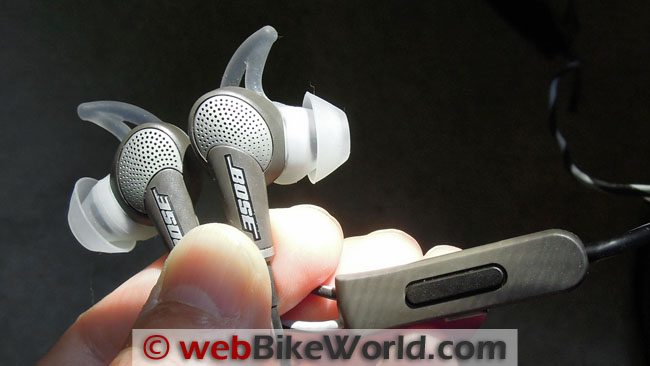
Where to Buy Bose QuietComfort 20
Check Reviews & Prices on AmazonSee More: Motorcycle Accessories, Motorcycle Tire, Motorcycle Helmets
Size and Helmet Fitment
Each Bose in-ear headphone (or speaker or earbud) is larger than the garden-variety type that comes with a generic MP3 player (do they still make those?) or cell phone.
But the overall profile fits nicely into the ear and is about flush with the outer surface or edges of the ear.
Like any earbud or headphone system, the Bose QC20 headphones can be tricky to keep in place when you’re putting on a helmet. S
ome helmets have larger ear pockets or cavities than others, and these types are preferred for using the Bose system.
Other helmets have no defined ear pockets, and these can be more difficult to put on when wearing the headphones.
You really have to be very careful about not pulling on the headphone wires; you don’t want to break a $300 system.
Also, sometimes the in-ear headphones will move out of correct location in the ear canal when the helmet is being put on, and this will affect the noise cancelling system performance.
Then you have the wire hanging down the front of your jacket.
In this case, because the wires are permanently attached to the Bose QC20 battery, I have to stuff the system, along with the MP3 player or cell phone, in my pocket or in a tank bag.
If it’s the latter, you then have to worry about forgetting you’re connected when you get off the bike. You have to unzip the tank bag and grab the battery and the device. Again, an extension cable could help here.
Sound Quality
I’m probably not what you’d call and audiophile, but I know good quality sound when I hear it. The Bose QC20 system sounds better than most of the other earbuds I’ve tried, which usually have a “tinny” sound.
But I’m certainly not blown away by the sound quality of the Bose system. It’s OK — better than most earbuds — but not superlative, in my opinion.
Of course, you will be able to hear music better with the Bose QC20 system activated when riding a motorcycle than with a standard set of non-noise-cancelling earbuds, so in that regard, the difference is dramatic.
Also, when the surrounding environment is quiet, there is a constant hissing sound that can be heard in the Bose QC20 system when it’s turned on. This may affect sound quality also.
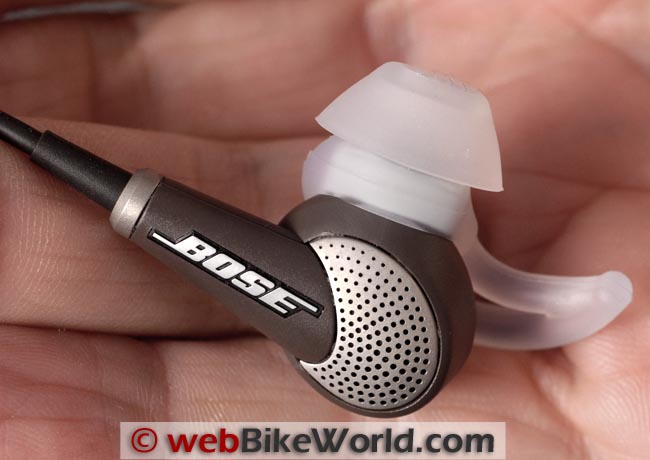
Conclusion
There’s no doubt that the Bose QuietComfort 20 Acoustic Noise Cancelling Headphones have amazing performance under certain conditions — the conditions that they were designed for.
But they don’t reduce the types of motorcycle noise as well as I’d hoped, including wind noise and exhaust noise.
We expected — or at least hoped for — a very quiet environment when wearing the Bose headphones.
But after riding a few different types of motorcycles and the BMW C 650 GT scooter (blog), we’re a little disappointed that the noise reduction seems about the equivalent of wearing a good pair of foam disposable ear plugs.
It’s sometimes not as good with the Bose system as it is with the ear plugs.
I would guess that the Bose QC20 system is probably designed primarily for sound environments like those found in an airplane or normal street use and not for motorcycle use.
Bottom line?
If you really need to listen to music or another device whilst riding a motorcycle, then perhaps the Bose QC20 headphones are the best current solution that will actually allow you to hear the sound while reducing overall noise levels.
But you may be better off simply using a motorcycle Bluetooth intercom system and connecting your cell phone or music player with the Bluetooth intercom headset.
You’ll actually pay less, get more features and will have fewer issues with the intercom speakers placed in the helmet ear pockets.
Hopefully, someday Bose will partner with a motorcycle helmet manufacturer to make a helmet with a built-in noise cancelling ear cup system specifically designed to address the types of noises generated by motorcycle riding.
More wBW Ear Plug Reviews | All wBW Motorcycle Product Reviews
Where to Buy Bose QuietComfort 20
Check Reviews & Prices on AmazonSee More: Motorcycle Accessories, Motorcycle Tire, Motorcycle Helmets
Owner Comments and Feedback
See details on submitting comments.
From “J.C.” (February 2017): ” I just bought a pair and I see this review is 4 years old so don’t know how much this changes things. But the Bose system has added many miles to my riding.
At 54 I’m sensitive to wind noise and have tried lot of gizmos over the years. Custom plugs, different foam, different helmets and helmet skirts none really did it for me. There was always that booming noise. The Bose system shuts that down!!!
I can hear the motor and exhaust but the drone of the booming is gone. I can hear some wind noise and they do pop when hit with the wind directly but they are wonderful for me. They are tricky to get on under a helmet at first, it does get easier.”
From “D.F.” (April 2014): “Thank you for the very informative read about the Bose QC20 ear buds.
After reading the article, I am pretty well convinced that I will save my $300 and continue to ride with my fitted silicone earplugs, albeit without music or talk shows.”
From “K.I.” (March 2014): “Another honest, detailed, intelligent review from webBikeWorld.com. Thank you “Mad Dog” Earle.
You wrote “I read a magazine review of the Bose QuietComfort 20 headphones and the reviewer was very specific about how any talking in the background turns to a whisper, but I find this to be not the case at all, which leaves me puzzled.
And no, I did not have the Bose “Award Mode” turned on.” Ha!
I appreciate your healthy skepticism and humor here.
To me, it’s a sign of intelligence and intellectual integrity. It makes your opinion as a journalist all the more valuable.
I did call you a “journalist”, because whether this is just a hobby for you and you don’t see yourself as a journalist, or not, I hold your work in higher esteem than much of what passes as journalism today.
In commercial media, we of course have a market driven by corporate advertising dollars.
Regrettably, there is a truth-warping, truth-polluting effect of the incentive structure created by this business model.
Your skepticism, honesty, and transparency don’t go unnoticed by me, and refreshingly stand out in a business filled with people writing empty content to fill web pages all in an attempt to secure more advertising revenue.
Unfortunately, it seems that in the media business, the end product and its value to the reader seems to matter less than anything else. But what you have done here is valuable. But I digress.
From what I’ve read online, and the noise-reduction data I’ve seen, the Bose QuietComfort 20 earphones are easily the best of their type.
I don’t think anyone will find a better headphone for noise cancellation.
I’ve seen plots of the sound-dampening capabilities of a handful of various models, measured across the audible frequency spectrum.
There are some other models from other manufacturers that are slightly better than the Bose QuietComfort 20 at cancelling higher frequencies, and cost less money.
I’ll explain below, but I think the reason those models are better at cancelling higher frequencies is only due to the design of the actual plug that interfaces with the ear canal.
I don’t think their implementation of active noise-cancellation technology is any better than Bose.
This seems to be universally validated by subjective reviews all over the internet.
The data I’ve seen also support this claim.
The Bose are way, way ahead of other manufacturers in dampening ambient noise, particularly the lower frequencies (the realm of active noise cancellation).
So, I think it’s safe to conclude that you will not find, as of 2014, a better implementation of active noise cancellation than this model by Bose. That’s unfortunate for us motorcyclists, as we’ve seen here how limited the technology currently is.
The technology is improving, but I think there are limitations that will always make it difficult for motorcycle applications.
Here’s what I know about this active “noise-cancelling” technology:
There is a microphone built into the earpiece that attempts to measure the phase, frequency, and amplitude of ambient sound waves about to hit your eardrum.
The closer the mic is to your eardrum, the more accurate the measurement of what the wave will look like when it actually hits your eardrum.
That signal is then sent to a connected processor that produces sound waves of equal amplitude.
It’s timed 180 degrees out of phase, such that the highest peaks of the ambient sound waves coincide with the lowest valleys of the processor-produced “cancelling” sound waves.
The two waves collide in your ear canal, and both “drop dead”, having cancelled each other out.
This is the ideal, and this technology strives to accomplish this ideal for as many unwanted ambient sound waves as possible.
This requires measurement of not only intensity and frequency, but timing of the wave phase. It’s a lot of rapid calculations, and it’s pretty amazing that it can do this at all.
There is an inherent latency involved with the measuring of sound waves, signal traveling back and forth over wires and processing.
So the technology may never be able to actively “cancel” unique and sporadic sounds as they enter your ear canal.
No amount of processing power and technology can accurately predict the future of what unwanted sound waves will hit your eardrums. The best it can do is react very quickly.
Because of this, it seems that this sort of technology will only ever be able to cancel out consistent, repetitive sound waves that the sound-cancellation algorithm assumes will continue, unchanged, into the future.
I think people call this white noise, or “droning” noise. Perhaps this is why the Bose QC20 earphones seem to be effective at cancelling only these sorts of ambient noise.
Essentially, the processor has to listen to the sound waves coming at your eardrums.
And then either produce the 180 degree opposite of all those ambient sound waves, or attempt to predict which waves will persist long enough to be actively “cancelled”.
Because of the latency inherent in processing such a complex algorithm in such a rapidly changing and unpredictable environment, I’m inclined to suppose that the processor does that latter.
Otherwise it risks producing cancelling sound waves that are never cancelled by their intended, but now absent, ambient waves because the ambient noise environment changed unexpectedly.
Producing “unanswered” noise-cancelling waves in this manner would be unfavorable because it would be using battery power to just produce more distracting noise in your ear canal.
The system would be better off just letting the unpredictable, random noise waves pass through if they occur.
So currently, at best, this device can only cancel persistent and consistent noise. There might still be hope for the future, however.
As processing gets faster, I suppose it’s possible that the signals moving through wires and processors will travel closer and closer to the speed of light (much faster than the speed of sound).
They could produce a sound-cancelling wave before the offending ambient wave hits your eardrum.
But, I suspect it will be difficult to accomplish.
Of course, the closer that mic is to your eardrum, the less time the technology has to react.
You could move the mic further away to buy more time, but unfortunately the further away from your eardrum the mic is, the less accurate the measurement of what the offending ambient soundwave will actually look like when it hits your eardrum.
So, the cancelling wave might not perfectly cancel the offending wave even if it makes it there in time.
This is an engineering challenge indeed.
Also, I’ve read that it is difficult for this technology to actively cancel sound waves in the higher frequency ranges.
I’m not sure why this is, but I suspect it has to do with the difficulty in measuring and producing such high frequencies with sufficient precision and speed.
High frequencies are much faster, with much less time to process and align the various peaks and valleys of these short-period, fast waves.
Essentially, you have a faster moving target, and if you fire even slightly late, you have the possibility of the two wave peaks coinciding and thereby doubling the sound pressure level (SPL) of the ambient noise.
You would thus be amplifying the ambient high frequency noise. That would obviously be counter productive.
Maybe as technology improves, they will improve at cancelling higher frequencies?
What puzzles me, is that it’s really necessary at all. High frequency sounds waves are easier to block, as their short wavelength can’t travel through physical barriers like lower frequencies can.
That’s why we can hear the kicking bass from the house party next door, but can’t hear the lyrics, cymbals, or other high frequencies.
The long wavelengths of low frequencies aren’t effectively blocked by physical barriers. Short wavelengths are.
In my opinion, this points out what I take to be a design flaw in the Bose QuietComfort 20 earphones.
Why didn’t they use a foam earplug much like the cheap “sound-isolating” ear plugs many of us like to use on our motorcycles?
The best ones, when properly inserted into the ear canal, reduce SPL by as much as 32 decibels depending on frequency.
I suppose Bose went for comfort and ease of use in their design for their target consumer (not motorcyclists).
Those who regularly use earplugs when riding know that inserting foam plugs deep into the ear canal can be tricky, and certainly not as convenient as just placing the earphone somewhat loosely into the ear opening.
If Bose would have used a foam earplug like Shure does on their seemingly excellent “sound isolating” earphones, Bose would have done much better at dampening (not cancelling) higher frequency sounds waves.
Examples: like wind whistling and ripping around your helmet, as well as erratic sounds like exhaust “pops” or pulses that change with engine RPM.
Both of these sorts of sound waves are going to be difficult for active noise cancellation technology to deal with, as they’re unpredictable.
Combine the sort of passive noise-isolating effects of a good set of foam earplugs with the superior low frequency active noise-cancellation technology Bose has.
That could result in an earphone that protects the motorcyclist from more riding noise than the best foam plugs can.
They could beat foam plugs with active noise cancellation technology because foam plugs aren’t good at blocking lower frequencies. Low frequencies can travel through the foam ear plug.
Current active noise cancelling technology excels at blocking lower frequencies.
The combination of the two would be the best we can achieve, all while giving us an opportunity to listen to music at reasonable SPLs on longer rides.
Unfortunately, Bose didn’t go that route. They opted for comfort and ease of use.
I’m willing to bet that the Bose QC20 earphones used in active cancellation mode under big over-the-ear sound isolation headphones, like those used at a gun range, would get us very close to that level of performance.
Unfortunately, driving a motorcycle with those sorts of big sound isolating headphones would prevent us from wearing a motorcycle helmet. I’m not sure that’s a tradeoff that a motorcyclist should make.
So, while I think the Bose QuietComfort 20 falls short of the dream for us motorcyclists, the dream is probably still possible.
A better, more sound isolating interface between the earphone and the human ear canal would help a lot.
I’m thinking here, of thick foam surrounds that go deep into the ear canal.
I would keep an eye out for that feature in any new noise-cancelling product as we look for the “perfect” earphone for motorcycling, if it’s even possible.
There are very high amplitudes or SPLs of the wind and road noise present in the helmet of a motorcyclist.
So it’s quite possible that more powerful amplification will be necessary to drive sound cancelling headphones with enough amplitude to effectively cancel the unwanted ambient noise.
That may be another feature we may need to watch for in any new noise-cancelling product.
It’s also possible that earphone driver design will have to mature to be able to produce SPLs high enough to cancel the high noise levels found in a motorcycle helmet.
I’m not even sure most tiny earphone drivers can handle the power necessary to produce noise-cancelling sound waves of sufficient amplitude to effectively cancel the loud road noise motorcyclists are exposed to at highway speeds.
I think it could be considered irresponsible for a manufacture to produce earphone drivers capable of 120 db sound pressure levels.
They’d have to be really careful as far as product liability lawsuits are concerned.
It’s quite possible that earphone drivers are inherently limited to avoid such sound pressure levels for safety’s sake.
My point is only that a perfect motorcycle earphone could possibly be made, but I wouldn’t hold my breath waiting for it.
As you can see, there are probably many hurdles to overcome before getting such a product to market.
But it would seem that Bose could easily start with a long, thick, sound-isolating foam earpiece to interface with the ear canal.
I suspect that, when combined with active noise-cancelling technology, would accomplish a lot for us motorcyclists.
Until then, if you must have music at safe SPLs for the safety of your long-term hearing, the best you could do would be the Bose QuietComfort 20 earphones paired with larger over-the-ear sound-isolating headphones.
But, I wouldn’t recommend it unless you’re comfortable with the risk of driving your motorcycle without a helmet.
Also, it goes without saying, that a tall windshield that directs wind up over your helmet would go a long way to improving ambient noise levels as well.
Until earphone manufacturers figure out a way to block the effects of excessive wind noise, it will be difficult to enjoy listening to music on a motorcycle at highway speeds.
Thank you again for your helpful review.”
From “R.B.” (February 2014): “I was very interested in reading all of the comments about the earphones. I have not yet tried them on my Yamaha Tenere but will as soon as the winter subsides.
However I have used these in my truck and passenger car and found the noise cancelling to be amazing and the road noise gone, gone.
I have also used them on airplanes. That supports the dampening of constant sounds ideas expressed.
There is a couple of factors you have not addressed, and one is the universality of sound needs.
To this I mention when you have been on a long motorcycle ride, there is the grueling time in a motel with the whining of the air conditioners or heaters.
I can tell you that with these, you will get a fantastic night’s sleep.
Then there is another reason to use them for music on the bike and that is the total amount of sound for your poor ears.
As I get older, I discover the importance of all of the hearing I lost by being ‘tough’ and cranking up the sound to shout above the wind noise or the earplug in between.
Once again, this is to endorse any way of reducing the total noise and not expecting miracles.
When I stopped whining about the price of the Bose and comparing that paltry sum with the prices of jackets, etc., not to mention a bike itself, I went for the best, no matter how flawed.
When something new comes out, I will embrace that, but until then I intend to keep my hearing.”
Editor’s Note: I’ve been wearing this pair on long flights and I’m a bit disappointed, they don’t block as much sound as I’d like or as I thought they would.
I do not find them useful at all on a motorcycle, I much prefer a good set of disposable ear plugs.
From “S” (October 2013): “Thank you for the review.
However, with respect, I believe you do not understand the limitations of a ‘noise cancelling’ headphone while riding a motorcycle: none, especially the “earbud” types, can eliminate the noise we motorcyclists experience while riding.
The problem is volume — on bike, in-helmet noise can approach 120dB. Very, very few full size headphones are capable of this volume and we won’t even discuss earbuds (peruse a few specs sheets).
The ‘noise cancelling’ headphone principle operates by analyzing the ambient sound and creating an inverse waveform that cancels the original out.
Therefore, in order to fully cancel a sound the inverse waveform must be of the same measured amplitude (volume). As earbuds cannot create the absolute volume necessary…you get what you experienced, incomplete sound cancellation.
I tried ‘noise cancelling’ earbud headphones while riding 5 years ago and experienced the incomplete cancellation myself.
That, and after 7 continuous days of riding with them in and the ear pain that created taught me a lesson: helmet speakers in conjunction with standard foam earplugs.
Earbuds work OK for shorter rides but add days and days of travel and you simply want to rip them out of your ears to end the inevitable pain that their pressure on your pinna causes.”
Editor’s Reply: Thanks for the feedback, but what you wrote confirms exactly what we stated in the review, so I’m not sure why you also wrote that we “do not understand the limitations of ‘noise cancelling’ headphone(s).”
From “P.O.” (September 2013): “I bought them to ride with my C 650 GT, I wear them under my Silky motorcycle helmet liner and it exceeded my expectations.
Is it perfect? No, but I am able to enjoy my music going down the road. Thanks for all your reviews.”
From “M.W.” (September 2013): “I have been using the Shure SE215 in-ear monitors for a while now when motorcycling (BMW K1200GT and SCHUBERTH C3 (review), Starcom1 (review).
And I use a Sansa Clip mp3 player, Motorola cellphone.
They have very good sound quality, fit flush with the ear, don’t come out putting on/taking off a helmet, and have superior noise isolation. Shure SE215’s are a great choice.”
From “G.H.” (September 2013): “I have tried these and at first felt that they should be quieter. But I came to realize that I don’t wear headphones in the car for very good reasons.
First, the ambient sound levels in the car do not interfere with my enjoyment of the stereo, and, second, I’d consider it unsafe to completely block out all traffic noise especially the occasional emergency vehicle.
In addition, I chose the bike I ride partly because I enjoy the sound it makes….at a safe volume of course.
The pricing IS steep so I am anxiously waiting for them to be up for sale on your website.
With all the concern over distracted driving and the “threat” of technologically controlled vehicles that provide audio warning signals, I think it would be a mistake to have true audio canceling devices for any mobile application for vehicle operators.”
Editor’s Note: No ear plugs or sound cancelling system we have ever tried will “completely block out all traffic noise”, much less emergency sirens.
A certain percentage of sound is transmitted through the skin, bones, etc. so you will always hear something.
A good set of ear plugs reduces noise and sound to safer levels and helps prevent the motorcyclist from permanent hearing loss.
From “R” (September 2013): “I conducted a similar test myself on a 1000+ mile ride. 600 miles into it, I went back to ear plugs sans music. The noise cancelling earbuds were a nice idea, but in reality, they didn’t work.
I just ordered the Sena SMH10 (review) to pipe in audio over and thru my foamie earplugs.”
From “C.A.” (September 2013): “I just read your review of the “Bose QuietComfort 20 Acoustic Noise Cancelling Headphones”.
They sound like a good solution to non-motorcycle environments where it is beneficial to block background noise but allow other important sounds (like commuting on a train, walking in a city, working in cubicles etc.).
But their inability to block (or reduce) wind noise to that of an average set of earplugs is disappointing.
For $300 there are a wealth of custom-molded options which block lots of noise, excellent sound quality, no electronic amplification wizardry. Personally I have enjoyed the Etymotic ER4i’s ($90) and Precision Lab’s Challengers ($200), in the past, now I have the Westone CR1’s ($270’ish).
But most of my friends find the $59 Etymotic MC5‘s to block as much noise as good earplugs.
They are all-day comfortable, and provide very good audio. Combines with the Sena SMH10’s and the earbud clamp they appear to be the best option on the market.”


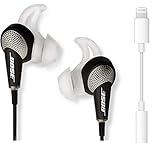

No Comment